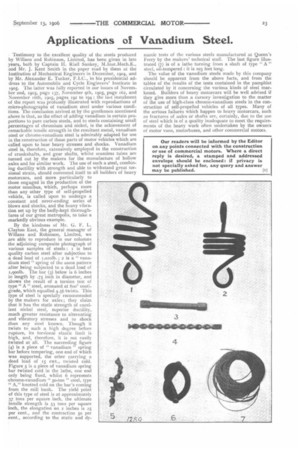Applications of Vanadium Steel.
Page 25

If you've noticed an error in this article please click here to report it so we can fix it.
Testimony to the excellent quality of the steels produced by Winans and Robinson, Limited, has been given in late years, both by Captain H. Riall Sankey, M,Inst,Mech.E., and Mr. J. Kent Smith in the paper read by them at the Institution of Mechanical Engineers in December, 1904, and by Mr. Alexander E. Tucker, F.I.C., in his presidential address to the Automobile and Cycle Engineers' Institute in 1905. The latter was fully reported in our issues of November and, 1905, page 137, November 9th, 1905, page 162, and November 16th, 1905, pages 192 to 194 : the last instalment of the report was profusely illustrated with reproductions of micro-photographs of vanadium steel under various conditions. The conclusion arrived at by the gentlemen mentioned above is that, as the effect of adding vanadium in certain proportions to pure carbon steels, and to steels containing small percentages of chromium and nickel, is the achievement of remarkable tensile strength in the resultant metal, vanadium steel or chrome-vanadium steel is admirably adapted for use in the construction of those parts of motor vehicles which are called upon to bear heavy stresses and shocks. Vanadium steel is, therefore, extensively employed in the construction of crankshafts, and gear shafts, whilst seamless tubes are turned out by the makers for the manufacture of hollow axles and for similar work. The use of such a steel, combining ductility with strength arid able to withstand great torsional strain, should commend itself to all builders of heavy motorcars, and more particularly to those engaged in the production of the motor omnibus, which, perhaps more than any other type of self-propelled vehicle, is called upon to undergo a .constant and never-ending series of blows and shocks, and the heavy vibration set up by the badly-kept thoroughfares of our great metropolis, to take a markedly obvious example.
By the kindness of Mr. G, F. L. Clayton East, the general manager of Winans and Robinson, Limited, we are able to reproduce in our columns the adjoining composite photograph of various samples of steels : i is best quality carbon steel after subjection to a dead load of r,o2o1b. ; 2 is a "vanadium steel " spring of the same pattern after being subjected to a dead load of 1,9oolb. The bar (3) below is 6 inches in length by .75 inch in diameter, and shows the result of a torsion test of type " A "steel, annealed at Soo centigrade, which equalled 4.56 twists. This type of steel is specially recommended by the makers for axles ; they claim that it has the static strength of excellent nickel steel, superior ductility, much greater resistance to alternating and vibratory stresses and to shock than any steel known, Though it twists to such a high degree before rupture, its torsional elastic limit is high, and, therefore, it is not easily twisted at all. The succeeding figure (4) is a piece of " vanadium " spring bar before tempering, one end of which was supported, the other carrying a dead load of 15 cwt., twisted cold. Figure 5 is a piece of vanadium spring bar twisted cold in the lathe, one end only being fixed, whilst 6 represents .chrome-vanadium " 50-ton " steel, type " A," knotted cold on the bar's coming from the mill bank. The yield point of this type of steel is at approximately 37 tans per square inch, the ultimate tensile strength is 53 tons per square inch, the elongation on 2 inches is 25 per cent., and the contraction so per ,cent., according to the static and dy
narnic tests of the various steels manufactured at Queen's Ferry by the makers' technical staff. The last figure illustrated (7) is of a lathe turning from a shaft of type " A " steel, oil-tempered : it is 103 feet long. The value of the vanadium steels made by this company should be apparent from the above facts, and from the tables of the results of the tests contained in the pamphlet circulated by it concerning the various kinds of steel marketed. Builders of heavy motorcars will be well advised if they give more than a cursory investigation to the matter of the use of high-class chrome-vanadium steels in the construction of self-propelled vehicles of all types. Many of the serious failures which happen to heavy motorcars, such as fractures of axles or shafts arc, certainly, due to the use of steel which is of a quality inadequate to meet the requirements of the heavy work often undertaken by the owners of motor vans, motorbuses, and other commercial motors.


























